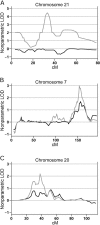New complexities in the genetics of stuttering: significant sex-specific linkage signals
- PMID: 16532387
- PMCID: PMC1424690
- DOI: 10.1086/501370
New complexities in the genetics of stuttering: significant sex-specific linkage signals
Abstract
Stuttering is a speech disorder long recognized to have a genetic component. Recent linkage studies mapped a susceptibility locus for stuttering to chromosome 12 in 46 highly inbred families ascertained in Pakistan. We report here on linkage studies in 100 families of European descent ascertained in the United States, Sweden, and Israel. These families included 252 individuals exhibiting persistent stuttering, 45 individuals classified as recovered from stuttering, and 19 individuals too young to classify. Primary analyses identified moderate evidence for linkage of the broader diagnosis of "ever stuttered" (including both persistent and recovered stuttering) on chromosome 9 (LOD = 2.3 at 60 cM) and of the narrower diagnosis of persistent stuttering on chromosome 15 (LOD = 1.95 at 23 cM). In contrast, sex-specific evidence for linkage on chromosome 7 at 153 cM in the male-only data subset (LOD = 2.99) and on chromosome 21 at 34 cM in the female-only data subset (LOD = 4.5) met genomewide criteria for significance. Secondary analyses revealed a significant increase in the evidence for linkage on chromosome 12, conditional on the evidence for linkage at chromosome 7, with the location of the increased signal congruent with the previously reported signal in families ascertained in Pakistan. In addition, a region on chromosome 2 (193 cM) showed a significant increase in the evidence for linkage conditional on either chromosome 9 (positive) or chromosome 7 (negative); this chromosome 2 region has been implicated elsewhere in studies on autism, with increased evidence for linkage observed when the sample is restricted to those with delayed onset of phrase speech. Our results support the hypothesis that the genetic component to stuttering has significant sex effects.
Figures




Similar articles
-
Genomewide significant linkage to stuttering on chromosome 12.Am J Hum Genet. 2005 Apr;76(4):647-51. doi: 10.1086/429226. Epub 2005 Feb 15. Am J Hum Genet. 2005. PMID: 15714404 Free PMC article.
-
Identification of an autosomal recessive stuttering locus on chromosome 3q13.2-3q13.33.Hum Genet. 2010 Oct;128(4):461-3. doi: 10.1007/s00439-010-0871-y. Epub 2010 Aug 13. Hum Genet. 2010. PMID: 20706738 Free PMC article.
-
A genetic linkage study in Brazil identifies a new locus for persistent developmental stuttering on chromosome 10.Genet Mol Res. 2014 Mar 24;13(1):2094-101. doi: 10.4238/2014.March.24.13. Genet Mol Res. 2014. PMID: 24737434
-
Genetic bases of stuttering: the state of the art, 2011.Folia Phoniatr Logop. 2012;64(1):34-47. doi: 10.1159/000331073. Folia Phoniatr Logop. 2012. PMID: 22067705 Free PMC article. Review.
-
Epidemiology of stuttering: 21st century advances.J Fluency Disord. 2013 Jun;38(2):66-87. doi: 10.1016/j.jfludis.2012.11.002. Epub 2012 Nov 27. J Fluency Disord. 2013. PMID: 23773662 Free PMC article. Review.
Cited by
-
Stuttering: Genetic updates and a case report.Adv Biomed Res. 2012;1:14. doi: 10.4103/2277-9175.96070. Epub 2012 May 11. Adv Biomed Res. 2012. PMID: 23210073 Free PMC article.
-
Genetic studies of stuttering in a founder population.J Fluency Disord. 2007;32(1):33-50. doi: 10.1016/j.jfludis.2006.12.002. Epub 2006 Dec 30. J Fluency Disord. 2007. PMID: 17276504 Free PMC article.
-
Characteristics of Fluency and Speech in Two Families With High Incidences of Stuttering.J Speech Lang Hear Res. 2015 Oct;58(5):1440-51. doi: 10.1044/2015_JSLHR-S-14-0080. J Speech Lang Hear Res. 2015. PMID: 26126023 Free PMC article.
-
Population-based genetic effects for developmental stuttering.HGG Adv. 2021 Dec 2;3(1):100073. doi: 10.1016/j.xhgg.2021.100073. eCollection 2022 Jan 13. HGG Adv. 2021. PMID: 35047858 Free PMC article.
-
Genome-wide association study to identify novel loci associated with therapy-related myeloid leukemia susceptibility.Blood. 2009 May 28;113(22):5575-82. doi: 10.1182/blood-2008-10-183244. Epub 2009 Mar 18. Blood. 2009. PMID: 19299336 Free PMC article.
References
Publication types
MeSH terms
Grants and funding
LinkOut - more resources
Full Text Sources
Other Literature Sources
Medical
Miscellaneous

